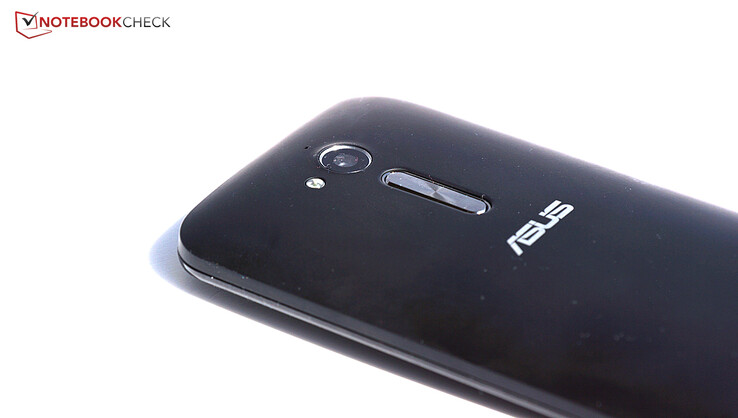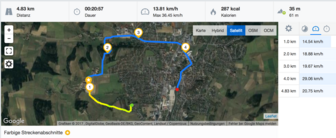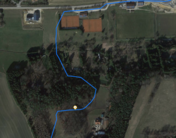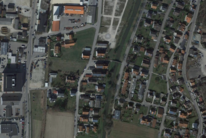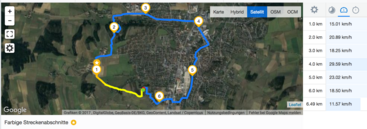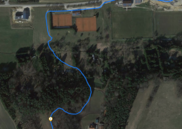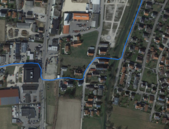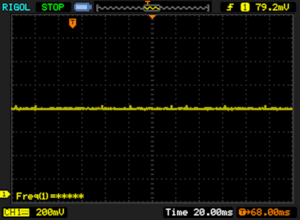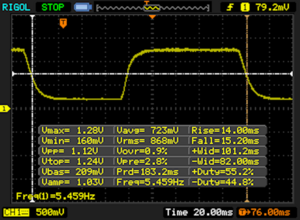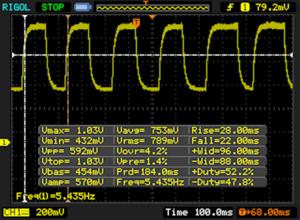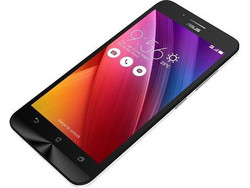Breve Análise do Smartphone Asus ZenFone Go
Os Top 10
» Os Top 10 Portáteis Multimídia
» Os Top 10 Portáteis de Jogos
» Os Top 10 Portáteis Leves para Jogos
» Os Top 10 Portáteis Acessíveis de Escritório/Empresariais
» Os Top 10 Portáteis Premium de Escritório/Empresariais
» Os Top 10 dos Portáteis Workstation
» Os Top 10 Subportáteis
» Os Top 10 Ultrabooks
» Os Top 10 Conversíveis
» Os Top 10 Tablets
» Os Top 10 Smartphones
» A melhores Telas de Portáteis Analisadas Pela Notebookcheck
» Top 10 dos portáteis abaixo dos 500 Euros da Notebookcheck
» Top 10 dos Portáteis abaixo dos 300 Euros
Size Comparison
| Networking | |
| iperf3 transmit AX12 | |
| Asus Zenfone Go ZB500KL | |
| Huawei P8 lite 2017 | |
| LG X Power K220 | |
| Lenovo K6 | |
| iperf3 receive AX12 | |
| Asus Zenfone Go ZB500KL | |
| Huawei P8 lite 2017 | |
| Lenovo K6 | |
| LG X Power K220 | |
| |||||||||||||||||||||||||
iluminação: 84 %
Contraste: 1093:1 (Preto: 0.42 cd/m²)
ΔE ColorChecker Calman: 4.5 | ∀{0.5-29.43 Ø4.78}
ΔE Greyscale Calman: 6.5 | ∀{0.09-98 Ø5}
96.23% sRGB (Calman 2D)
Gamma: 2.22
CCT: 7791 K
| Asus Zenfone Go ZB500KL IPS, 1280x720, 5" | LG X Power K220 IPS, 1280x720, 5.3" | Wiko U Feel IPS, 1280x720, 5" | Lenovo K6 IPS, 1920x1080, 5" | Huawei P8 lite 2017 IPS, 1920x1080, 5.2" | |
|---|---|---|---|---|---|
| Screen | -11% | 14% | 5% | 9% | |
| Brightness middle (cd/m²) | 459 | 381 -17% | 500 9% | 470 2% | 575 25% |
| Brightness (cd/m²) | 452 | 352 -22% | 485 7% | 461 2% | 559 24% |
| Brightness Distribution (%) | 84 | 85 1% | 83 -1% | 88 5% | 91 8% |
| Black Level * (cd/m²) | 0.42 | 0.2 52% | 0.22 48% | 0.38 10% | 0.39 7% |
| Contrast (:1) | 1093 | 1905 74% | 2273 108% | 1237 13% | 1474 35% |
| Colorchecker dE 2000 * | 4.5 | 7.3 -62% | 6.3 -40% | 5.2 -16% | 5.2 -16% |
| Colorchecker dE 2000 max. * | 10.6 | 21.2 -100% | 14.4 -36% | 9.5 10% | 10.3 3% |
| Greyscale dE 2000 * | 6.5 | 7.4 -14% | 5.2 20% | 5.6 14% | 7.2 -11% |
| Gamma | 2.22 99% | 2.26 97% | 2.17 101% | 2.24 98% | 2.4 92% |
| CCT | 7791 83% | 8417 77% | 7536 86% | 7924 82% | 7224 90% |
* ... menor é melhor
Cintilação da tela / PWM (modulação por largura de pulso)
| Tela tremeluzindo / PWM não detectado | |||
[pwm_comparison] Em comparação: 53 % de todos os dispositivos testados não usam PWM para escurecer a tela. Se PWM foi detectado, uma média de 8118 (mínimo: 5 - máximo: 343500) Hz foi medida. | |||
Exibir tempos de resposta
| ↔ Tempo de resposta preto para branco | ||
|---|---|---|
| 29 ms ... ascensão ↗ e queda ↘ combinadas | ↗ 14 ms ascensão | |
| ↘ 15 ms queda | ||
| A tela mostra taxas de resposta relativamente lentas em nossos testes e pode ser muito lenta para os jogadores. Em comparação, todos os dispositivos testados variam de 0.1 (mínimo) a 240 (máximo) ms. » 76 % de todos os dispositivos são melhores. Isso significa que o tempo de resposta medido é pior que a média de todos os dispositivos testados (20.2 ms). | ||
| ↔ Tempo de resposta 50% cinza a 80% cinza | ||
| 50 ms ... ascensão ↗ e queda ↘ combinadas | ↗ 28 ms ascensão | |
| ↘ 22 ms queda | ||
| A tela mostra taxas de resposta lentas em nossos testes e será insatisfatória para os jogadores. Em comparação, todos os dispositivos testados variam de 0.165 (mínimo) a 636 (máximo) ms. » 85 % de todos os dispositivos são melhores. Isso significa que o tempo de resposta medido é pior que a média de todos os dispositivos testados (31.6 ms). | ||
| AnTuTu v6 - Total Score (classificar por valor) | |
| Asus Zenfone Go ZB500KL | |
| LG X Power K220 | |
| Wiko U Feel | |
| Lenovo K6 | |
| Huawei P8 lite 2017 | |
| Geekbench 4.0 | |
| 64 Bit Single-Core Score (classificar por valor) | |
| Asus Zenfone Go ZB500KL | |
| LG X Power K220 | |
| Lenovo K6 | |
| Huawei P8 lite 2017 | |
| 64 Bit Multi-Core Score (classificar por valor) | |
| Asus Zenfone Go ZB500KL | |
| LG X Power K220 | |
| Lenovo K6 | |
| Huawei P8 lite 2017 | |
| 3DMark | |
| 1280x720 offscreen Ice Storm Unlimited Score (classificar por valor) | |
| Asus Zenfone Go ZB500KL | |
| LG X Power K220 | |
| Wiko U Feel | |
| Lenovo K6 | |
| Huawei P8 lite 2017 | |
| 1280x720 offscreen Ice Storm Unlimited Graphics Score (classificar por valor) | |
| Asus Zenfone Go ZB500KL | |
| LG X Power K220 | |
| Wiko U Feel | |
| Lenovo K6 | |
| Huawei P8 lite 2017 | |
| 1280x720 offscreen Ice Storm Unlimited Physics (classificar por valor) | |
| Asus Zenfone Go ZB500KL | |
| LG X Power K220 | |
| Wiko U Feel | |
| Lenovo K6 | |
| Huawei P8 lite 2017 | |
| 2560x1440 Sling Shot OpenGL ES 3.0 (classificar por valor) | |
| Asus Zenfone Go ZB500KL | |
| LG X Power K220 | |
| Wiko U Feel | |
| Lenovo K6 | |
| Huawei P8 lite 2017 | |
| 2560x1440 Sling Shot OpenGL ES 3.0 Graphics (classificar por valor) | |
| Asus Zenfone Go ZB500KL | |
| LG X Power K220 | |
| Wiko U Feel | |
| Lenovo K6 | |
| Huawei P8 lite 2017 | |
| 2560x1440 Sling Shot OpenGL ES 3.0 Physics (classificar por valor) | |
| Asus Zenfone Go ZB500KL | |
| LG X Power K220 | |
| Wiko U Feel | |
| Lenovo K6 | |
| Huawei P8 lite 2017 | |
| GFXBench (DX / GLBenchmark) 2.7 | |
| T-Rex Onscreen (classificar por valor) | |
| Asus Zenfone Go ZB500KL | |
| LG X Power K220 | |
| Wiko U Feel | |
| Lenovo K6 | |
| Huawei P8 lite 2017 | |
| 1920x1080 T-Rex Offscreen (classificar por valor) | |
| Asus Zenfone Go ZB500KL | |
| LG X Power K220 | |
| Wiko U Feel | |
| Lenovo K6 | |
| Huawei P8 lite 2017 | |
| GFXBench 3.0 | |
| on screen Manhattan Onscreen OGL (classificar por valor) | |
| Asus Zenfone Go ZB500KL | |
| LG X Power K220 | |
| Wiko U Feel | |
| Lenovo K6 | |
| Huawei P8 lite 2017 | |
| 1920x1080 1080p Manhattan Offscreen (classificar por valor) | |
| Asus Zenfone Go ZB500KL | |
| LG X Power K220 | |
| Wiko U Feel | |
| Lenovo K6 | |
| Huawei P8 lite 2017 | |
| PCMark for Android - Work performance score (classificar por valor) | |
| Asus Zenfone Go ZB500KL | |
| LG X Power K220 | |
| Wiko U Feel | |
| Lenovo K6 | |
| Huawei P8 lite 2017 | |
| Octane V2 - Total Score (classificar por valor) | |
| Asus Zenfone Go ZB500KL | |
| LG X Power K220 | |
| Wiko U Feel | |
| Lenovo K6 | |
| Huawei P8 lite 2017 | |
| JetStream 1.1 - Total Score (classificar por valor) | |
| Asus Zenfone Go ZB500KL | |
| LG X Power K220 | |
| Wiko U Feel | |
| Lenovo K6 | |
| Huawei P8 lite 2017 | |
| Mozilla Kraken 1.1 - Total (classificar por valor) | |
| Asus Zenfone Go ZB500KL | |
| LG X Power K220 | |
| Wiko U Feel | |
| Lenovo K6 | |
| Huawei P8 lite 2017 | |
* ... menor é melhor
| AndroBench 3-5 | |
| Sequential Read 256KB (classificar por valor) | |
| Asus Zenfone Go ZB500KL | |
| LG X Power K220 | |
| Wiko U Feel | |
| Lenovo K6 | |
| Huawei P8 lite 2017 | |
| Sequential Write 256KB (classificar por valor) | |
| Asus Zenfone Go ZB500KL | |
| LG X Power K220 | |
| Wiko U Feel | |
| Lenovo K6 | |
| Huawei P8 lite 2017 | |
| Random Read 4KB (classificar por valor) | |
| Asus Zenfone Go ZB500KL | |
| LG X Power K220 | |
| Wiko U Feel | |
| Lenovo K6 | |
| Huawei P8 lite 2017 | |
| Random Write 4KB (classificar por valor) | |
| Asus Zenfone Go ZB500KL | |
| LG X Power K220 | |
| Wiko U Feel | |
| Lenovo K6 | |
| Huawei P8 lite 2017 | |
| Sequential Read 256KB SDCard (classificar por valor) | |
| Asus Zenfone Go ZB500KL | |
| LG X Power K220 | |
| Wiko U Feel | |
| Lenovo K6 | |
| Huawei P8 lite 2017 | |
| Sequential Write 256KB SDCard (classificar por valor) | |
| Asus Zenfone Go ZB500KL | |
| LG X Power K220 | |
| Wiko U Feel | |
| Lenovo K6 | |
| Huawei P8 lite 2017 | |
(+) A temperatura máxima no lado superior é 38 °C / 100 F, em comparação com a média de 35.2 °C / 95 F , variando de 21.9 a 247 °C para a classe Smartphone.
(+) A parte inferior aquece até um máximo de 35.3 °C / 96 F, em comparação com a média de 34 °C / 93 F
(+) Em uso inativo, a temperatura média para o lado superior é 31.5 °C / 89 F, em comparação com a média do dispositivo de 32.9 °C / ### class_avg_f### F.
Asus Zenfone Go ZB500KL análise de áudio
(±) | o volume do alto-falante é médio, mas bom (###valor### dB)
Graves 100 - 315Hz
(-) | quase nenhum baixo - em média 28.6% menor que a mediana
(±) | a linearidade dos graves é média (10.2% delta para a frequência anterior)
Médios 400 - 2.000 Hz
(+) | médios equilibrados - apenas 4.8% longe da mediana
(+) | médios são lineares (6.1% delta para frequência anterior)
Altos 2 - 16 kHz
(+) | agudos equilibrados - apenas 3.1% longe da mediana
(+) | os máximos são lineares (4.5% delta da frequência anterior)
Geral 100 - 16.000 Hz
(±) | a linearidade do som geral é média (25.8% diferença em relação à mediana)
Comparado com a mesma classe
» 64% de todos os dispositivos testados nesta classe foram melhores, 6% semelhantes, 29% piores
» O melhor teve um delta de 11%, a média foi 35%, o pior foi 134%
Comparado com todos os dispositivos testados
» 79% de todos os dispositivos testados foram melhores, 4% semelhantes, 17% piores
» O melhor teve um delta de 4%, a média foi 24%, o pior foi 134%
Huawei P8 lite 2017 análise de áudio
(+) | os alto-falantes podem tocar relativamente alto (###valor### dB)
Graves 100 - 315Hz
(-) | quase nenhum baixo - em média 32.1% menor que a mediana
(±) | a linearidade dos graves é média (11.2% delta para a frequência anterior)
Médios 400 - 2.000 Hz
(+) | médios equilibrados - apenas 4% longe da mediana
(+) | médios são lineares (6.4% delta para frequência anterior)
Altos 2 - 16 kHz
(±) | máximos mais altos - em média 7.9% maior que a mediana
(+) | os máximos são lineares (4.8% delta da frequência anterior)
Geral 100 - 16.000 Hz
(±) | a linearidade do som geral é média (27.6% diferença em relação à mediana)
Comparado com a mesma classe
» 72% de todos os dispositivos testados nesta classe foram melhores, 5% semelhantes, 24% piores
» O melhor teve um delta de 11%, a média foi 35%, o pior foi 134%
Comparado com todos os dispositivos testados
» 84% de todos os dispositivos testados foram melhores, 3% semelhantes, 13% piores
» O melhor teve um delta de 4%, a média foi 24%, o pior foi 134%
| desligado | |
| Ocioso | |
| Carga |
|
Key:
min: | |
| Asus Zenfone Go ZB500KL 2600 mAh | LG X Power K220 4100 mAh | Wiko U Feel 2500 mAh | Lenovo K6 3000 mAh | Huawei P8 lite 2017 3000 mAh | |
|---|---|---|---|---|---|
| Power Consumption | 10% | -22% | 2% | -43% | |
| Idle Minimum * (Watt) | 0.92 | 0.64 30% | 0.82 11% | 0.65 29% | 1.44 -57% |
| Idle Average * (Watt) | 1.76 | 1.3 26% | 1.61 9% | 1.65 6% | 2.47 -40% |
| Idle Maximum * (Watt) | 1.85 | 1.34 28% | 1.8 3% | 1.67 10% | 2.58 -39% |
| Load Average * (Watt) | 3.47 | 4.18 -20% | 5.99 -73% | 3.58 -3% | 4.55 -31% |
| Load Maximum * (Watt) | 4.22 | 4.87 -15% | 6.7 -59% | 5.58 -32% | 6.3 -49% |
* ... menor é melhor
| Asus Zenfone Go ZB500KL 2600 mAh | LG X Power K220 4100 mAh | Wiko U Feel 2500 mAh | Lenovo K6 3000 mAh | Huawei P8 lite 2017 3000 mAh | |
|---|---|---|---|---|---|
| Duração da bateria | 54% | -3% | 22% | 5% | |
| Reader / Idle (h) | 20.4 | 27.1 33% | 22.1 8% | ||
| H.264 (h) | 10.3 | 10.6 3% | 10.7 4% | ||
| WiFi v1.3 (h) | 9.5 | 16.5 74% | 9.2 -3% | 11.9 25% | 10.1 6% |
| Load (h) | 4.6 | 6.1 33% | 5.8 26% | 4.7 2% |
Pro
Contra
Com o ZenFone Go, a Asus entrega um smartphone que se posiciona com firmeza na gama média-baixa. A carcaça sólida, a bateria removível, e as boas fotos da câmera em boas condições de iluminação falam pelo aparelho. No entanto, o comprador deve aceitar o desempenho relativamente baixo, que apresenta ao navegar pelo menu. Além disso, o módulo GPS tem falhas e a tela alcança um contraste médio e tem uma iluminação irregular.
Em nossa opinião, é agradável que a Asus entregue seu aparelho com as correções de segurança mais recentes da Google via atualizações. No entanto, uma atualização para o sistema operacional mais recente não deve ser esperada nesta faixa de preços. A precisão de cores relativamente expansiva da tela, e o bom manuseio também são pontos positivos.
O ZenFone Go oferece aspectos positivos, como a bateria removível e a sólida carcaça. No entanto, a Asus poderia ter lhe outorgado um pouco mais de poder.
No geral, podemos recomendar o ZenFone Go para usuários que não dependem do alto desempenho. No entanto, o comprador deve estar ciente de que existem alguns modelos impressionantes da concorrência, como o Huawei P8 lite (2017) ou o Lenovo K6, pelo mesmo preço ou apenas um pouco mais alto.
Asus Zenfone Go ZB500KL
- 04/03/2017 v6 (old)
Florian Wimmer




